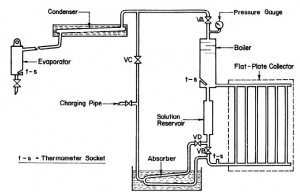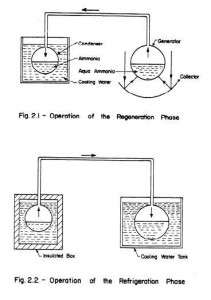“I can’t stand to write my essays for pages and pages when a simple presentation with blueprints would have sufficed!” Sounds familiar? Writing is frustrating for many STEM majors. Luckily, you have us for everything: writing, calculations, and bold ideas!
Abstract
This paper presents the design of a solar powered refrigeration system. The design of the system takes into account the solar sorption principles which include both the absorption and adsorption. Research has been conducted and it has been proven that the design and implementation of solar refrigeration system comes with several advantages. It helps in meeting the demand for energy conservation and the protection of the environment.
The production of most of the systems that use solar power for refrigeration purposes are in small scale. However, there is need for more research to be done in order to ensure that larger systems are also manufactured to aid the process of cooling through the use of solar energy. In this project, we will concentrate only on designing a refrigeration system that uses solar energy as its main source of power. The design will also see the implementation of a prototype so as to help us in determining the viability of the project. Solar powered refrigeration system has been a subject that has received a lot of publicity in the recent past. Several governments have put in place mechanisms of controlling harmful emissions to the environment and also devise ways of controlling the amount of energy consumed. Designing a system that relies on entirely solar energy will help in achieving some of the goals for the developing countries of having a clean source of energy and also reduce their reliance on fossil fuels and national electricity grid. This study was therefore commissioned in order to design a system that could be used to provide an alternative to the traditional cooling systems that not only damages the environment through the emissions of CFCs and HCFCs that deplete the ozone layer but also reduce the stretching on the national electricity grid in terms of energy consumption. This paper therefore covers the design issues of the solar refrigeration system and also proposes a prototype that can be used to demonstrate the functionalities of the system.
Table of Contents
-
- Abstract
-
- Table of Contents
-
- Nomenclature
-
- Chapter 1: Introduction
-
- Objectives of the study
-
- Summary of the system
-
- Background information
-
- Benefits of a solar powered refrigerator
-
- Chapter 2: Literature review
-
- Chapter 3: Approach/Methodology/Experimental Procedure
-
- Operation of the refrigeration system
-
- Technology details
-
- Optimizing the performance of they system
-
- Forms of energy transfer
-
- Operating principles of the system
-
- Absorption
-
- Adsorption
-
- Chapter 4: Results
-
- Chapter 5: Conclusions & further work
- References
Nomenclature
CFCs - chlorofluocarbures
HCFCs – hydrochlorofluorocarbures
HFCs - hydrofluocarbures
Chapter 1: Introduction
Solar energy has been a topic of research for several years. Researchers have been faced with a task of designing a system that will reduce the overdependence on the national electricity grid and also reduce the amount of harmful fumes that are emitted into the atmosphere. This research revolves around designing a solar powered refrigeration system. It also involves designing a prototype that will show how the refrigerator will work and some of the technical accomplishments. When developing a solar cooling system, there are several points that need to be taken into consideration. It should be made clear on whether the device is to be used as a solar cooler or as a solar ice maker. The size of the device also needs to be taken into consideration. Any solar cooling system will have the following two parts: a cooling unit and a solar heat source. The cooling unit of the system uses a thermodynamic cycle which is similar to the one used in the traditional refrigeration systems. The solar heat source on the other hand consists of a plat plate used for collecting sun radiations. In order to determine whether the system is economically and operationally viable, we need to measure its coefficient of performance which is the ratio of achieved cooling to the supplied heat.
Objectives of the study
This study forms part of a project aimed at designing a solar powered refrigerator. It is also aimed at developing a unit that will be able to use only the solar energy to provide a source of power for its use. It also involves the development and design of a prototype that can be used to exhibit the value and the economic feasibility of solar energy.
There are several reasons why it is important to consider solar energy as a source of energy that can be used to meet the energy needs of several countries across the globe. Solar energy is a cheap source of energy since sunlight is free and most of the developing countries are in the tropics thus making solar radiation easily available. Solar provides a good source of clean energy that does not pollute the environment thus making it a number one choice for people who are keen in managing the environment.
Summary of the system
The design of a solar powered refrigeration system involved the designing of a square solar panel which is 1.2m in length. In the design, no oil or electricity is used for the process. It uses the principle of ammonia-water intermittent absorption. Regeneration of the refrigerator takes place at day time while the refrigeration takes place at night. Rapid absorption of the system takes place through a process whereby heat of absorption is dissipated from the plate. In the generator compartment of the system, 15kg of a solution containing about 46% of ammonia in water is used. When the atmosphere is clear, the temperature of the ammonia solution rises from about 300C to 880C. During this time, between 0.9 kg to 1kg of pure ammonia is condensed at a temperature of 320C. At night during refrigeration, the temperature of ammonia drops to -70C. The average solar coefficient of the performance is about 0.09. This is obtained by dividing the cooling effect by the solar heat which is absorbed.
Background information
The production of cold temperatures through a sustainable process has been a subject of study for several decades. Cold is very essential in several fields of human life. It is needed in the food processing field, conservation of medical products like the vaccines and some drugs, air conditioning sector among others. However, the traditional refrigeration systems that are in use negatively contribute towards achieving sustainable development. There are two major problems which need to be addressed here in order to come up with systems which can achieve their goals and objectives effectively while at the same time helping in conserving the environment. The two problems that need to be addressed are the increase consumption of the global limited primary energy and the environmental impacts of the refrigeration systems. A system is therefore required that will help in solving the above problems caused by the use of the traditional refrigeration systems. The convectional refrigeration systems increase the consumption of electricity energy and fossil fuel utilization. According to the International institute of refrigeration, about 15% of the energy produced in the whole world is used for refrigeration purposes. The traditional refrigerants also on the other hand use some fluids like the chlorofluocarbures commonly known as the CFCs, hydrochlorofluorocarbures also known as the HCFCs and the hydrofluocarbures known as the HFCs. These fluids are very harmful to the environment as they contribute greatly to the depletion of the ozone layer. Therefore different researches have been instigated in order to find a long lasting solution to the problems posed by the use of the traditional cooling systems. Solar refrigeration technologies are therefore the best remedies for such problems. Solar refrigeration is also the best solution since the time when cooling is needed most is the time when there is plenty of sunshine. Therefore implementation of the solar cooling technologies comes as a blessing in disguise. This paper is mainly going to deal with the principles of solar sorption refrigeration technologies and the design of solar refrigerators.
Benefits of a solar powered refrigerator
A solar powered refrigerator has the following benefits:
-
- i. Longevity – it can be able to operate continuously for several years. This capability has been proved by some of the prototypes that have been implemented and tested in several countries across the globe.
-
- ii. Scalable – it is possible to have a cooling system in a manageable size. It is possible to have small refrigerators or even big ones that are the size of a building depending on the needs.
- iii. Environmentally friendly – This type of refrigerator makes use of the sun energy hence minimizing the reliance on the use of fossil fuels. It also reduces the usage of batteries that can be very damaging to the environment when they are disposed off.
Chapter 2: Literature review
According to Bahli et al (1970) there are several possibilities for the development of icemakers through the use of solar energy. They stated that icemakers and refrigerators can be easily made both for domestic and commercial purposes. The icemakers therefore need to be as automatic and efficient as possible so as to be able to competitively compete with the available systems that use electrical energy for their operation. The authors therefore proposed a solar refrigeration as one of the major fields of research that more energy needs to be concentrated on so as to help in solving the problem of storage which is common in developing countries.
Merriam (1972), on the other hand stated that of all the research work on solar energy that have been conducted, solar refrigeration was one of the most promising fields of study. When solar energy is converted into an ice making process, it helps solve the problem of storage since ice can be stored for several months thereby giving about the cooling sensation of the system even when there is no sunlight available. According to the author, icemakers are the most useful devices in developing countries especially in places whereby there is no electricity.
According to the survey which was conducted by Swartman and Newton (1973), it was realized that the first study that was conducted to implement the usage of solar energy for refrigeration was in 1936 at the University of Green. During this time, steam jet refrigerator was powered using steam that was produced though heating water that was flowing in a pipe and then placed at some focal line of the clylindro-parabolic reflector (Swartman and Newton, 1973). This was the first project that made solar refrigeration a reality and many scholars worked on improving the system so as to make more advanced units.
Chinnappa (1962) on the other hand managed to build a simple refrigerator that was operated with a flat plate collector for collecting sunlight radiations. In the design, he used a generator absorber that was welded and then incorporated with a flat-plate collector. This was then connected to a water cooled absorber. The solar collector which was used in the design was a copper sheet painted black. The working fluid for this system was ammonia-water solution.
The figure shown below shows the refrigeration system that was designed by Chinnappa in 1962 that is operated using a flat plate collector for collecting the sunlight radiations.
Chapter 3: Approach/Methodology/Experimental Procedure
Operation of the refrigeration system
The figure shown below shows a simple system that consists of two different containers that are connected using a pipe as shown below. The container labeled A has aqueous ammonia and it works as the generator-absorber. The container labeled B has pure ammonia and it forms the condenser-evaporator compartment. This system has two phases namely the regeneration and the refrigeration phases.
In the regeneration phase, container A which contains ammonia solution is heated. When the solution is being heated, pressure increases until the condensation pressure is reached. When the condensation pressure is reached, ammonia refines off and then in the evaporator-condenser.
The heat that is supplied during regeneration can be calculated using the formula

Whereby
W is the weight of the aqueous solution
H is the definite enthalpy of the aqueous solution
dW is the differential mass of the vapor that will vaporize out of the liquid. Therefore, the expression for the Coefficient of Performance will become:

In the refrigeration phase, the generator absorber is permitted to cool and the pressure then goes down and ammonia starts to evaporate thus extracting heat from the surrounding. This process causes the cooling of the system.
Technology details
This system uses photovoltaic cells to covert the solar energy into some form of electrical energy. The system also has vapor compressor used for cooling the system. One the sunlight energy has been converted into electrical energy by the use of the Photovoltaic cells, this power then drives the compressor. The compressor is driven to initiate the flow of refrigerant through a loop of vapor compression. This flow of vapor then extracts heat from an insulated inclusion thus in the process bringing about a cooling effect of the system. The enclosure has the thermal reservoir and a material meant for changing the phase. When heat is extracted from the inclusion, the material will then freeze. This process is very effective as it aids in the creation of icepack which is very essential for cooling the system especially when there is no sunlight. If proper sizing is done for the whole system and a desirable size of the compressor is used, the system will be able to stay cold throughout thus making the process very efficient without any worry of power blackouts or lack of sunlight at some instances to bring about the cooling of the system.
Optimizing the performance of they system
In order to optimize the performance of the system, the processor control method that is used, needs to fully exploit the energy obtained from the sun. The power voltage also has to be smoothened throughout the capacitor to provide more current when the compressor is being started up. A controller is then used to monitor the rate of change of the power voltage that is smoothed. The controller speed can then be adjusted as appropriate in order to ensure optimization of the performance of the system. The system has a capillary tube which should be replaced with an expansive valve so as to improve the energy efficiency of the system especially when the operating conditions of the system change. The adjustments do contribute to the conversion of most of the solar energy that is available into stored thermal energy in the system. Addition of electronic controls can also be made in order to provide power backup from alternative sources so as to ensure continuous functionality of the system especially in low sunlight seasons or in places that experience low sunlight.
The diagram shown below is a systematic representation of a solar icemaker. The solar icemaker shown uses carbon methanol and could produce about 5-6 kilograms of ice per square meter of the collector. In order to improve the performance of his solar icemaker, the heat conveying properties of the absorber should be adjusted. This can be easily achieved through the use of fins or using a compacted absorbent.
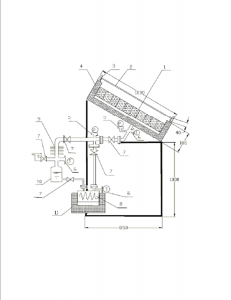
Parts of the solar icemaker
-
- 1. Adsorbent bed
-
- 2. Glass cover
-
- 3. Damper
-
- 4. Insulation
-
- 5. Pressure gauge
-
- 6. Temperature
-
- 7. Valves
-
- 8. Evaporator
-
- 9. Condenser
-
- 10. Refrigerant reservoir
- 11. Ice box
This system was later improved with the development of a new solar icemaker that does not use valves. The absorber in this case is manufactured from stainless steel and not from the traditional aluminum that was common to earlier systems. The new absorber is then placed inside a case covered using plastic fiber sheets. The plastic covers are preferred to the glass due to it has a relatively higher permeability to solar radiation. In order to ensure improved heat transfer, more fins are placed inside the absorber. Each fin is separated from each by a separation distance of 10cm.

-
- 1. Cover plate
-
- 2. Adsorbent bed
-
- 3. Insulation
-
- 4. Condenser
-
- 5. Evaporator
-
- 6. Water tank
- 7. Cold box
This solar icemaker is more efficient and can be able to produce more ice within a relatively smaller area thus ensuring power usage optimization.
There are several working pairs that have been proposed to help in the cooling process. The working pairs have different advantages and disadvantages depending on the nature of cooling to be conducted and the operational environment. The two major working pairs that have been used over time are the H2O–LiBr and NH3–H2O. In H2O–LiBr pair, water is used as the refrigerant and LiBr is used as the absorbent while in the NH3–H2O pair, is used as the refrigerant while water is used as the absorbent. Generally the NH3–H2O pair is commonly used for refrigeration purposes while the H2O–LiBr pair is commonly used for air conditioning purposes. Other working pairs include NH3–CaCl2 and SrCl2.
Forms of energy transfer
There are three forms at which energy is transferred in the system. The energy transmissions are done in form of heat at three different levels namely the atmospheric temperature Ta, the temperature of heat being taken from the cold chamber and the temperature of heat being obtained in the generator. In the operation of the system, heat transfers are reversible and the following equation of efficiency can be obtained:
![]()
Whereby
![]() is the quantity of heat received
is the quantity of heat received
![]() is the temperature at which the heat is received
is the temperature at which the heat is received
![]() is the temperature at which heat is rejected
is the temperature at which heat is rejected
![]() is the efficiency of the system
is the efficiency of the system
The coefficient performance of the refrigerator can be obtained by reversing the equation as shown below:
![]()
The coefficient of performance of the system can be obtained using the formula
![]()
The importance of this result is that the coefficient of performance can be easily calculated.
The current systems that are used to produce cold using the solar thermal energy mainly use the principle of sorption. This is the process that involves absorption by the liquid gas and the adsorption by the solid gas. The process of adsorption is mainly concerned with separating a substance from one phase of existence and then settling onto the surface of another substance. Consequently, absorption involves a given substance being transferred in its liquid form and then interpenetrating another phase to form a solution. The main difference between the two processes is the nature of the sorbent and the time that it takes for the sorption cycle to complete. The time taken for absorption is usually longer than the time taken for adsorption.
The main factors that affect the efficiency of a solar powered refrigeration system are thermal and solar coefficient of performance commonly referred to as the thermal COP and the solar COP.
The thermal COP can be calculated by dividing the cooling power of the system by the energy received by the system:
The solar COP on the other hand can be calculated by dividing the cooling power of the system by the energy received by the solar collector:
![]()
When calculating the solar COP, we will incorporate the solar collector efficiency. This will make it to be weaker that the thermal COP calculated above.
The overall performance of the system can therefore be obtained by getting the product of the two ratios.
We then obtain the following equation:
![]()
Operating principles of the system
The system operates through two main principles (Absorption and adsorption)
Absorption
The fact behind absorption is the mixture of gas in a liquid. The two fluids must have very high affinity in order to mix up and form a solution. This process is usually reversible and the constituent original fluids can be obtained back once the task has been completed. The process therefore goes on in a cycle. In the system, there is a pump that brings the solution of the two fluids into a zone of high pressure. The mixture is then heated. Once the mixture has been heated, the refrigerant is then separated from the absorbent. The emergent vapors of the refrigerant are then sent onto the condenser. As the refrigerant evaporates, a sensation of cold is then created. The remaining solution is then turned over into the absorber. The solution then absorbs the vapor of the refrigerant and the cycle starts all over again.
The diagram shown below shows a schematic representation of an absorption chiller where the processes of absorption takes place.

The following graph is then obtained to show on how the cycle affects the temperature inside the system.
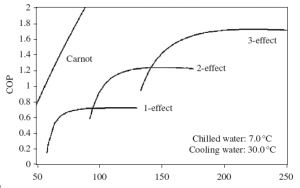
Adsorption
This is an observable fact that results from the involvement between a solid and a gas. The solid acts as the adsorbent while the gas is the refrigerant. This process is based on a physical and a chemical reaction occurrence. This process involves the use of a generator, a condenser and an evaporator. The generator used in the process has a solar plate which has the adsorbent (solid). This plate is then heated by the radiation from the sun. This can be represented as shown in the diagram that follows:

In most cases, fixed adsorbent beds are used which ensures that the cycles are operated without any moving parts. Using fixed beds has several advantages over the use of moving beds. Some of the advantages include, silence, longer life-time, high reliability and mechanical simplicity of the system. This helps in improving the COP of the system. However, if there is need of having a constant flow of vapor from the evaporator to achieve continuous cooling, two or more beds can be used. The beds have to be operated out of phase as shown in the diagram shown below:
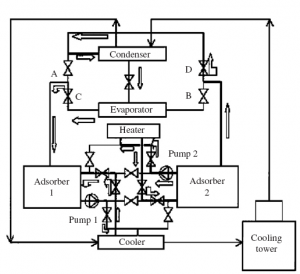
In the solar powered refrigeration systems, water, ammonia and methanol are used as adsorbents.
The figure shown below shows the layout of the experimental system designed.
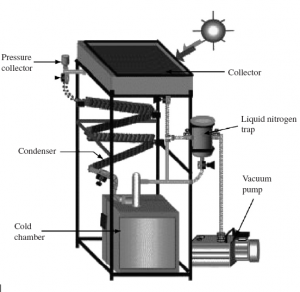
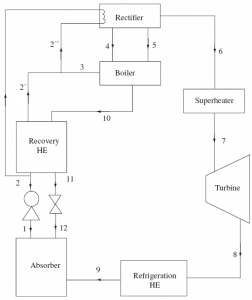
Chapter 4: Results
The refrigeration system that uses solar as the main source of energy has more advantages than its disadvantages. It can help the developing countries to achieve their development goals since there will be less power consumed from the national grid. The implementation of different fluid pairs for the refrigeration systems results into different values of Coefficient of performance. After carrying out through research, it has been proven that combining water and ammonia can be one of the best ways to achieve refrigeration through the use of the solar energy.
In this project, we have taken an insight overview on the design of a solar powered refrigeration system. From the above discussions, it is evident that solar powered refrigeration systems can be used to produce a wide range of cold temperatures. There are quite a number of technologies that are available that not only meet the cooling needs but helps in energy conservation and admirable environment management practices.
Chapter 5: Conclusions & further work
After carrying out thorough research and analysis in the field of solar powered refrigeration systems, we can conclude that implementing a solar refrigeration system is one of the best ways of achieving efficiency and ensuring that environment conservation is upheld. There is need to carry out more research in this field since the available literature cannot satisfactorily help in implementing more sophisticated solar refrigeration units that can be able to handle huge tasks. Using solar energy to provide the driving force for the refrigeration system is a big achievement in the field of designing solar appliances and equipments. It is not only cheap but also helps in reducing energy consumption from the natural grid and also reducing environmental pollution. The solar powered refrigeration system removes the...


